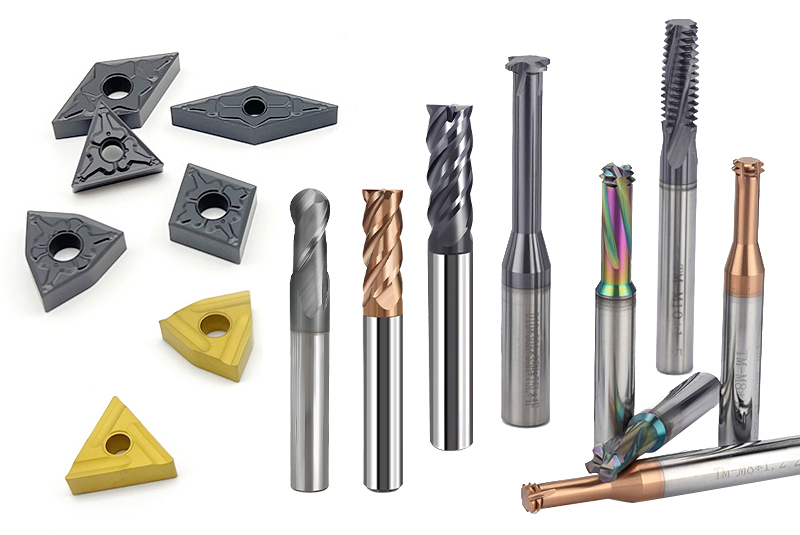In modern CNC machining, especially in industries such as aerospace, automotive, mold making, and energy equipment manufacturing, the performance of carbide cutting tools has become a critical factor in achieving high efficiency and precision.
One of the most effective ways to enhance tool performance is through coating technologies — particularly Physical Vapor Deposition (PVD) and Chemical Vapor Deposition (CVD) . These two methods offer different benefits depending on the application, and understanding their strengths can help you make smarter choices in your machining process.

Why Coating Matters for Carbide Tools
Carbide tools are known for their hardness and wear resistance, but even the best substrate can benefit from an advanced surface treatment. Tool coatings serve three primary functions:
- Enhanced Wear Resistance : Coatings increase the hardness of the cutting edge, reducing flank wear and cratering during continuous or interrupted cuts.
- Thermal Protection : High-speed or dry machining generates extreme heat; coatings act as a thermal barrier, protecting the base material from degradation.
- Improved Lubricity : A smoother surface reduces friction, minimizes built-up edge (BUE), and helps chips flow away more easily.
These properties allow coated tools to last longer, perform better under pressure, and maintain dimensional accuracy over time.
Understanding PVD Coating Technology
Physical Vapor Deposition (PVD) is a low-temperature coating method that deposits thin, dense layers onto the tool surface using physical processes like sputtering or evaporation.
Key Features:
- Coating thickness: typically 1–5 microns
- Process temperature: around 200–500°C
- Excellent adhesion and sharp edge retention
Ideal Applications:
- Precision machining of materials like aluminum, stainless steel, and titanium
- Dry cutting or minimal lubrication environments
- Operations requiring excellent surface finish and tight tolerances
PVD coatings are often used for finishing operations , where sharp edges, low cutting forces, and clean chip evacuation are essential. They are also preferred when maintaining dimensional accuracy is crucial.
Understanding CVD Coating Technology
Chemical Vapor Deposition (CVD) involves depositing thick, durable coatings through chemical reactions at high temperatures, typically between 800–1100°C.
Key Features:
- Coating thickness: up to 5–15 microns
- High thermal stability and oxidation resistance
- Can be applied in multiple layers for enhanced protection
Ideal Applications:
- Heavy-duty machining of cast iron, hardened steels, and nickel-based alloys
- Roughing operations with high feed rates and deep cuts
- Environments with high thermal load and mechanical stress
CVD coatings provide superior protection against abrasive wear and thermal degradation, making them ideal for roughing and semi-finishing applications. Their thicker structure offers long-lasting durability, especially in aggressive cutting conditions.
Real-World Performance Comparison
While both PVD and CVD coatings improve tool life and performance, their effectiveness depends heavily on the specific machining scenario.
For example:
- In roughing operations , uncoated tools quickly fail due to high temperatures and mechanical shock. PVD-coated tools show improvement but may still experience chipping due to their sharper edge geometry. In contrast, CVD-coated tools maintain consistent wear patterns and resist cratering and edge breakdown much better.
- In precision finishing , PVD shines by offering cleaner cuts, reduced burring, and superior surface finish. CVD-coated tools, while durable, may not deliver the same level of detail due to their slightly blunter cutting edge.
How to Choose Between PVD and CVD?
When selecting a coating type, consider the following factors:
- Type of Operation : Is it roughing or finishing?
- Material Being Cut : Is it soft (aluminum) or hard (cast iron)?
- Cutting Conditions : Are you using coolant or dry machining?
- Tool Geometry Requirements : Do you need a razor-sharp edge or a robust cutting tip?
As a general rule:
- Use PVD coating for precision, light-load, and high-surface-quality applications
- Use CVD coating for heavy-duty, high-temperature, and long-duration cutting tasks
Some advanced manufacturers now offer hybrid or multi-layer coatings that combine the advantages of both technologies, providing a versatile solution for complex machining needs.
SDFTools: Your Partner in High-Performance Coated Tools
At SDFTools , we specialize in designing and manufacturing high-performance carbide cutting tools tailored to your specific machining requirements. Our product range includes end mills, thread mills, solid carbide drills, gun drills, boring tools, and turning inserts — all available with customized PVD or CVD coatings.
We apply advanced German and Japanese technologies and operate under ISO 9001 quality standards to ensure every tool we produce delivers reliable performance, long life, and cost-effective results.
Whether you’re working on aerospace components, automotive parts, molds, or precision engineering projects, our expert team is ready to help you choose the right coating solution for your job.
Final Thoughts
The choice between PVD and CVD coatings comes down to matching the tool’s capabilities with your machining goals. Both technologies have distinct advantages, and selecting the right one can significantly impact productivity, part quality, and overall cost efficiency.
By understanding how each coating performs under different conditions, you’ll be better equipped to optimize your tooling strategy and achieve superior machining results.

